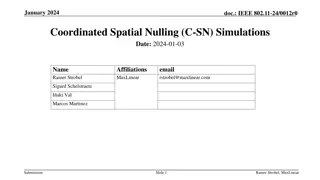Gain Analysis for Coordinated AP Transmissions in IEEE Enterprise R3 Network
This document discusses gain analysis results for coordinated AP transmissions in the IEEE Enterprise R3 network, focusing on tail latency gain for aperiodic traffic. Simulation setups, topology details, and results for different coordination schemes (C-TDMA, C-RTWT, and combined) are provided, show
5 views • 6 slides
Coordinated AP Time/Frequency Sharing in IEEE 802.11be
The document discusses Coordinated AP (CAP) Time/Frequency Sharing in Transmit Opportunity in IEEE 802.11be, focusing on Frequency and Time resource sharing between multiple APs in close proximity. It introduces concepts like CAP OFDMA and CAP TDMA, outlining the benefits in terms of latency improve
0 views • 15 slides
Coordinated AP Time/Frequency Sharing in IEEE 802.11be
The document discusses the concept of Coordinated AP (CAP) Time/Frequency Sharing within a Transmit Opportunity (TXOP) in the IEEE 802.11be standard. It explains the procedures of Frequency and Time resource sharing, highlighting the benefits such as latency improvement and throughput fairness. Deta
2 views • 16 slides
Coordinated Spatial Nulling (C-SN) Simulations in IEEE 802.11-24/0012r0
The document discusses the concept of Coordinated Spatial Nulling (C-SN) in IEEE 802.11-24/0012r0, focusing on spatial nulling feedback, synchronization needs, advantages of partial nulling, and comparison of half-coordinated versus fully coordinated scenarios. Simulation results are presented, anal
0 views • 19 slides
Preemption Methods for Ultra High Reliability in Multi-AP C-TDMA
In this IEEE document, preemption methods are discussed for the coordinated time-division multiple-access (C-TDMA) scheme to enhance the Ultra High Reliability (UHR) capability in multi-AP operation. The focus is on reducing delays during large PPDU transmissions and improving coordination between s
0 views • 8 slides
Enhancing Low Latency in IEEE 802.11 Networks
Various mechanisms for low latency in IEEE 802.11 networks are discussed, including C-TDMA, C-RTWT, TXOP Preemption, and HiP-EDCA. This proposal aims to improve initial control frame exchanges to prioritize low latency traffic transmission. By modifying exchange rules and allowing STAs to signal the
0 views • 12 slides
IEEE 802.11-24/411r0 TXOP Return in C-TDMA
This document discusses the TXOP return mechanism in C-TDMA operation for IEEE 802.11 networks. It explores the importance of timely TXOP return for efficient utilization of medium and proposes considerations for implementing TXOP return in C-TDMA. Various TXOP return scenarios and frame types are a
0 views • 11 slides
Wireless Sensor Networks: Medium Access Protocols Overview
This collection of images presents key concepts in wireless sensor networks, focusing on medium access protocols, the ISO/OSI reference model, types of conflict resolution, contention-free protocols, Bitmap protocol, ALOHA algorithm, and its analysis and efficiency. Various protocols and algorithms
1 views • 83 slides
Proposed MAP Channel Access Procedures in IEEE 802.11-24/72r0
In the May 2024 document IEEE 802.11-24/72r0, a uniform MAP coordination framework is discussed, involving procedures like M-AP discovery, coordinated transmissions, and channel access mechanisms. All APs in a coordination group can compete for channel access and share transmission opportunities. Th
0 views • 10 slides
Enhancing AP Coordination for Improved Wireless Network Performance
This document discusses considerations for Coordinated TDMA (C-TDMA) in IEEE 802.11 networks to address issues of limited coordination among Access Points (APs). The objective is to enhance coordination among APs to improve network reliability in terms of latency, throughput, and fairness. Design pr
0 views • 14 slides
Multi Division in Networking: Access Methods & Duplexing Techniques
Reviewing the concepts of multi-division in networking, this content delves into the need for multiple control channels, challenges in sharing channels, techniques like ALOHA and CSMA, and the importance of control channels and data channels. It explores access methods for control and data channels,
0 views • 20 slides
Coordinated TDMA Protocol in UHR: Negotiation & Agreement
Multi-AP coordination schemes, especially Coordinated TDMA (C-TDMA), play a crucial role in achieving efficient communication. This document discusses the protocol for negotiation and agreement among APs participating in C-TDMA in the UHR spectrum.
0 views • 11 slides











